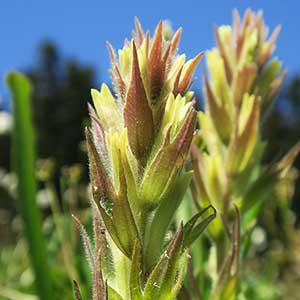Castilleja cryptantha
Castilleja rubicundula
Mt. Rainier or obscure paintbrush, obscure Indian paintbrush, obscure paintbrush
cream sacs
few to several, erect or ascending, unbranched, hairs spreading, long, soft, eglandular, mixed with short stipitate-glandular ones.
solitary, erect, unbranched, sometimes branched, hairs spreading, short, soft, often mixed with stipitate-glandular ones.
green, often with brown or purple veins, narrowly to broadly lanceolate, 1.5–4 cm, not fleshy, margins plane, ± involute, 0–3-lobed, apex acute to acuminate;
lobes spreading-ascending, narrowly lanceolate, apex acute to ± obtuse.
green to purple-tinged or dark red-brown, linear-lanceolate or distal lanceolate, 2–8(–9) cm, not fleshy, margins plane, flat to slightly curved up, 0–7-lobed, apex acute to acuminate;
lobes widely spreading or ascending-spreading, linear, apex acute.
(2.5–)3–6 × 1–2 cm; green to dull brown or dull reddish purple throughout, or proximally green to dull brown or dull reddish purple, distally yellow on apices, broadly lanceolate to ovate, (0–)3-lobed;
lobes ascending, narrowly lanceolate, long or short, arising near mid length, apex acute or acuminate.
2.5–24 × 3–4 cm;
bracts green throughout, lanceolate to ovate, 5–9-lobed;
lobes ascending, linear-lanceolate or lanceolate, medium length, arising near mid length, apex acute to acuminate.
straight, 14–16 mm;
tube 11–14 mm;
whole corolla included within calyx;
beak adaxially pale yellow, 1–2 mm;
abaxial lip deep green, slightly inflated, 4–5 mm, 67% as long as beak;
teeth ascending, pale, 1.5–2 mm.
straight, (15–)20–28 mm;
tube 8–24 mm;
abaxial lip, beak, and proximal part of corolla tube exserted;
beak adaxially white, rarely very pale yellow or pale pink-purple, 5–7 mm, inconspicuously puberulent;
abaxial lip white, fading to pink to pink-purple, or yellow, fading to white, rarely then to pink or pink-purple, both forms often with purple or red dots at base, inflated, prominent, pouches 3, 8–10 mm wide, 4–6 mm deep, 4–6 mm, 80–100% as long as beak;
teeth erect, white or yellow, 0.5 mm.
proximally green or pale with green veins, lobes yellow, sometimes becoming deep red with age, 12–15 mm;
abaxial and adaxial clefts 3–7 mm, 25–50% of calyx length, deeper than laterals, lateral 1–3(–4) mm, 8–20% of calyx length;
lobes triangular, adaxial segments longer than abaxials, apex acute or obtuse.
green, 8–14 mm;
abaxial and adaxial clefts 3–6 mm, 30–50% of calyx length, all 4 clefts subequal;
lobes linear, apex acuminate to acute.
± exserted, as long as or slightly longer than beak and visible from abaxial side.
= 24.
= 24.
Castilleja cryptantha
Castilleja rubicundula
Castilleja cryptantha is endemic to the vicinity of Mt. Rainier in the Cascade Range, with most populations found within Mt. Rainier National Park. Unlike most species of Castilleja, it is apparently self-pollinating (W. J. Duffield 1972); the small flowers are entirely enclosed within the yellowish calyces, which tend to grow deep reddish as they age. The purplish brown bracts are also unusual in the genus.
(Discussion copyrighted by Flora of North America; reprinted with permission.)
Varieties 2 (2 in the flora).
Castilleja rubicundula is separated into two varieties on the basis of flower color, as well as subtle differences in the pouching of the abaxial corolla lip. The ranges of the two varieties are broadly overlapping, but they never grow in the same location. Few intermediate forms have been recorded, though a very unusual population system exists in Santa Clara County, within which virtually all plants exhibit a tricolored corolla sequence, with yellow flowers aging to white and then pink or pink-purple, with all three colors visible on mature inflorescences.
(Discussion copyrighted by Flora of North America; reprinted with permission.)
1. Abaxial lips of corollas white, in most populations quickly fading to pink or pink-purple. | var. rubicundula |
1. Abaxial lips of corollas light to bright yellow, in some populations quickly fading to white, then rarely to pink or pink-purple. | var. lithospermoides |


